It's Panda Time!
Chengdu is proud of its pandas. Extremely proud.
Abstract pandas stand tall in the main square, opposite a gargantuan Chairman Mao and a stone’s throw from Gucci and Louis Vuitton. No self-respecting corner shop would be complete without panda-branded cigarettes, while the toy stalls churn out goodies from kitschy toddler-sized panda capes through to even kitschier panda purses.
There’s even a dedicated floral display…
In fact, if you’ve heard of this city of 11 million people in any context other than lists of “Chinese cities you’ve never heard of that are bigger than yours” (and yes, I plead guilty), you’ll have heard of the pandas.
And, more specifically, the Panda Breeding & Research Base, which does rather more than it says on the tin. From its two panda nurseries and panda kindergarten to the Panda Hospital and Panda Museum, it spans the gamut from unbearably cute to, frankly, plain bizarre.
Now “cute”, like “cuddly” and “adorable”, is a word I would normally only use at gunpoint.
But, please, I beg you, take a look at these baby pandas. In their (yes, really!) playpen.
Look! They’re like soft toys. Only they move. A bit…
They’re about four months old, these little fellas, born, like all pandas, in the summer. When they’re a bit bigger and more robust, they’ll go off to the panda kindergarten to join their mums.
Like this little guy, clambering all over his mother who was oh-so-clearly trying to sleep. The classic pesky toddler, he reminded me of the baby orangutan we saw bothering his mother back in Borneo.
Baby pandas, in fact, have every bit as much of an awww factor as mother and baby koalas, and considerably more awww factor than baby turtles. They are — and I do not say this lightly — even cuter than an entire family of tarsiers.
Z, who is a sucker for puppies and the like, goes googly-eyed at the sight of them and pulls out his camera.
He is also rather jealous of the giant panda lifestyle.
“That’s pretty much all they do, isn’t it?” he remarks. “Eat and sleep.”
Pandas eat, in fact, for approximately 16 hours a day, consuming roughly Z’s bodyweight (30kg) in bamboo from a position as close to horizontal as possible.
In between meals? Well, they like to take a nap.
Or two.
Pretty much wherever they land.
When not napping or eating, the museum explains: “Pandas move slowly to conserve energy.”
It seems equally unkind and impractical that one early emperor trained up pandas to use as weapons of war (alongside leopards and tigers).
Yet, the more we learn about giant pandas — and with everything from a panda hospital to a panda bakery plus oodles of pandas and lovely walking trails on site, that’s a LOT — the more bizarre it seems that there are any alive today.
Or, as Z puts it, “Pandas should have died out about eight million years ago.”
They are, of course, almost extinct today. There’s currently a couple of thousand in the wild, almost all of them here in Sichuan province, with a couple of pockets elsewhere in China.
The rest are captive bred and reared.
Why?
Well, first there’s the diet. Pandas are, biologically speaking, carnivores, but have adapted to eat, umm, bamboo (though they will top up with carrion and any small animal ill enough to move slower than them). The bamboo species pandas eat are prone to die off over large periods at random, forcing them to migrate.
Slowly.
Pandas are, outside the mating season, solitary creatures — each adult requires around six square kilometres of forest to itself, territory that it marks fervently. And humans have, of course, shrunk the forest.
And then…
Well, if you, like me, grew up in a city with pandas in its zoo, you’ll remember that getting them to mate, let alone procreate, was REAL BIG NEWS.
And the panda museum goes into, frankly, eye-opening detail on how the Mummy and Daddy pandas make the lovely little baby pandas.
With photos.
Graphic photos.
Photos even more unnerving than their panda taxidermy display.
And that is pretty unnerving.
How graphic?
Well, my spawn exclaims: “Why are they doing it up the arse? And how on earth can they do it like that in a tree?”
My embarrassment threshold is, I like to think, pretty high. Still, I gulp slightly, steel myself, and look around for anyone who appears to speak English. The coast seems clear.
“They’re not ‘doing it up the arse’,” I say, then take a deep breath and enter full liberal parent mode. “The phrase you’re looking for is ‘from behind’.”
“I know THAT,” he says.
Not for the first time, I reel like a Victorian lady whose corsets are overly laced. “HOW do you know that?” I splutter.
He’s TEN, for god’s sake.
“I watch Family Guy and American Dad,” he says.
Horse… Bolted… Stable door…
And, come to think of it, the puppet sex scene we both cringed through in Team America was probably at least as educational as the panda museum…
Anywise.
Central to the challenge of panda reproduction is, to put the matter more delicately than my son might, a mismatch.
Such that if pandas were people, Daddy Panda would be scrolling frantically through his spam folder looking for helpful emails, while Mummy Panda counselled pregnant friends to remember their Kegels and muttered darkly about leakage.
Not surprisingly, perhaps, Daddy and Mummy Pandas are also a little shy about doing it in front of an audience.
So, at least in Chengdu, panda procreation proceeds by way of artificial stimulation (I understand by way of machine, rather than some unfortunate panda fluffer), sperm screening and a most unromantic anaesthetised procedure…
A second challenge facing pandas in the wild is how these gorgeous babies emerge. A mummy panda weighs 100kg, or thereabouts. A newborn panda, which resembles nothing so much as a bald, pink mouse with a chopped-off tail, weighs 100 GRAMMES, or thereabouts.
So, yes, of course the poor creatures drop them… sit on them… accidentally suffocate them…
Because pandas aren’t the most physically adept of creatures. Even shovelling bamboo into their mouths, an activity which consumes almost all their waking hours (they do also like to drink water), seems as strenuous as a novice exploring chopsticks.
Worse yet? Almost half the time, Mummy Panda will give birth to twins. As she can’t raise two, she’ll select one to live, and the other to die, immediately after birth.
So here in Chengdu the babies are removed at birth, and raised on formula in a sort of nesting box which allows the mothers space to bond. But not enough space to, well, you know, sit on them…
Pandas are beautiful creatures. They’re a wonder to watch. And it is, in every sense, a miracle they exist.

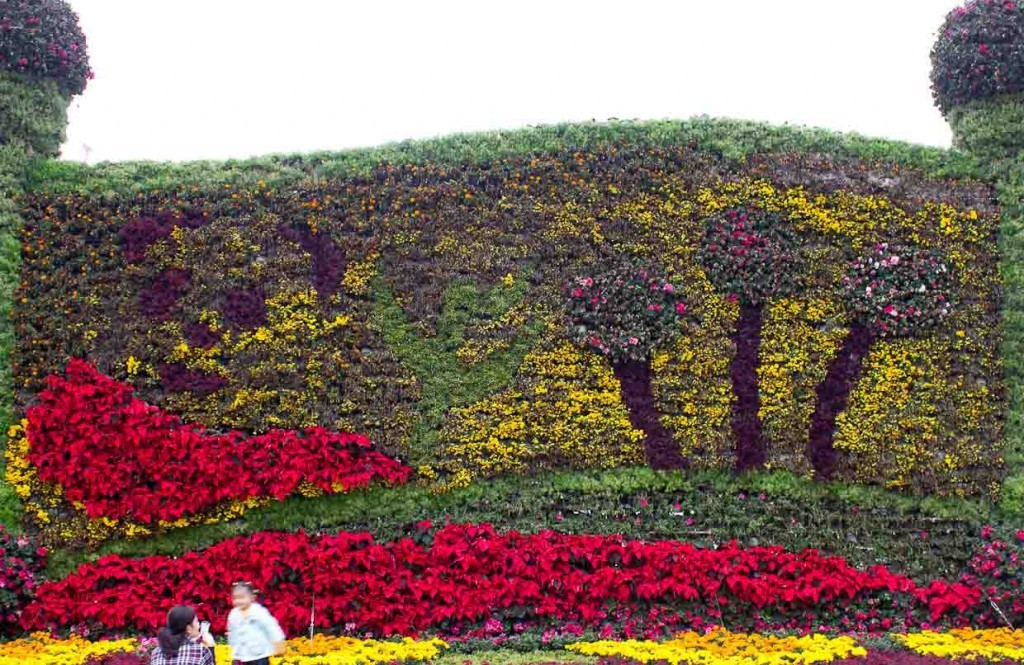
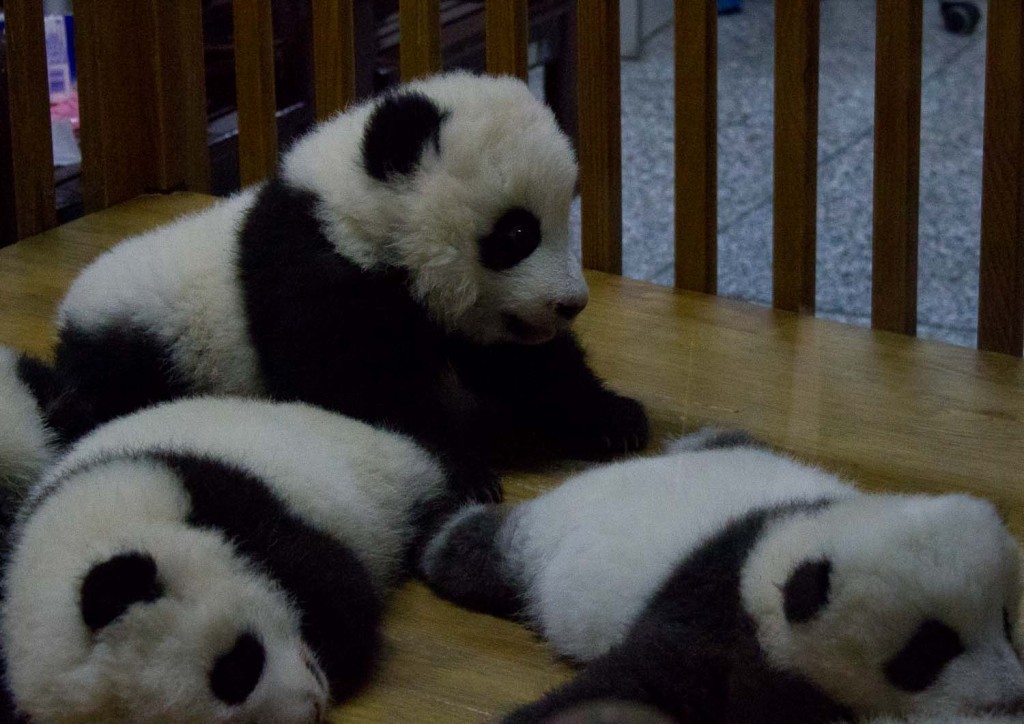
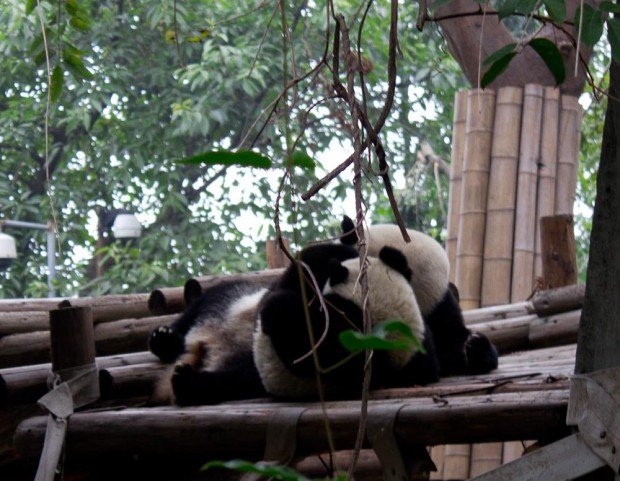
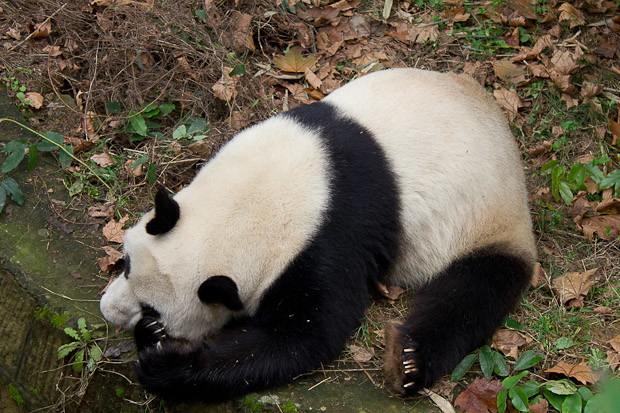
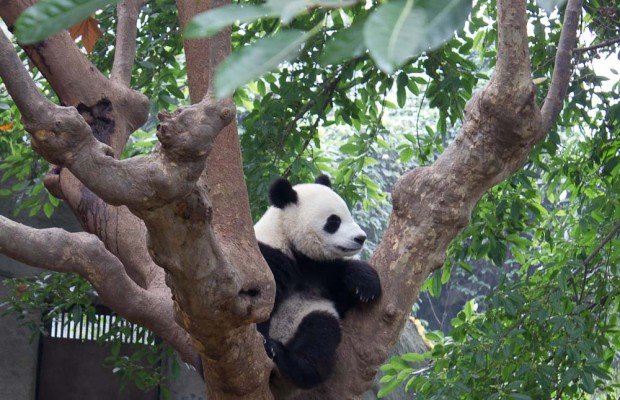
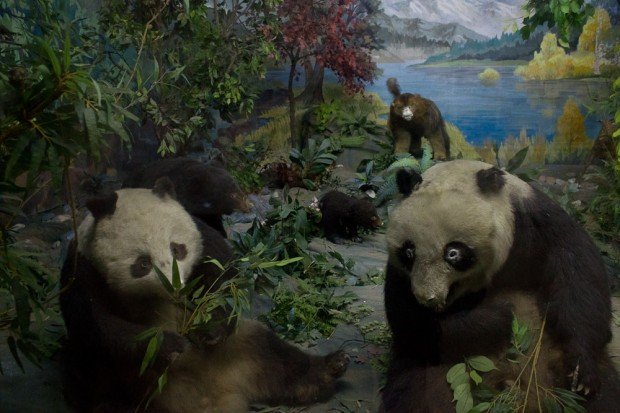
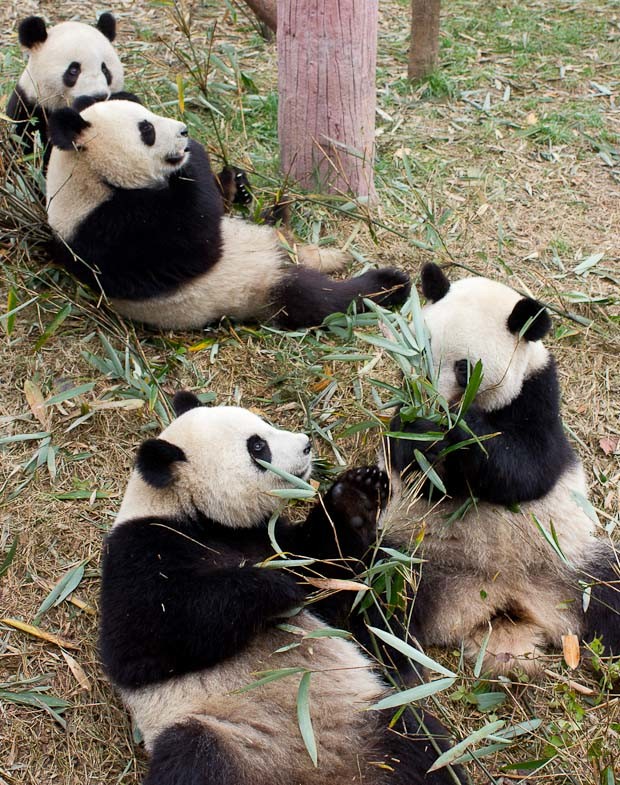
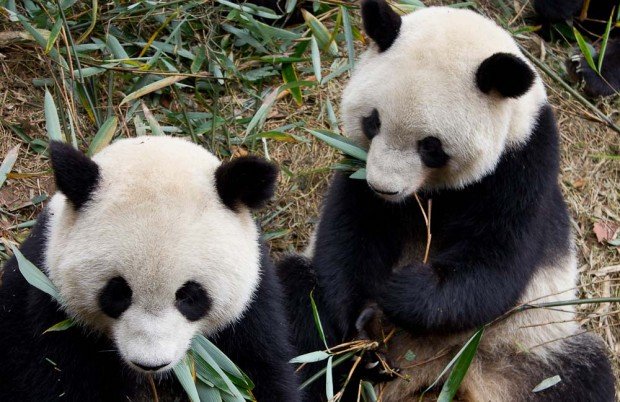
Um, I was just in China TODAY. Please tell me we didn’t cross paths!
Also, I didn’t see pandas. *sad panda face*
Ah, you have not lived until you’ve seen the ickle baby pandas, Kristin. Which bit of China are you in now? We’re in Chengdu at the moment, Xi’an in a couple of days…
it is a miracle that they exist! those babies are too cute for words!
We both just melted, Jessie.
What a funny explanation of pandas!! Those babies are just sooo cute! My 10 year old son came running to see what was wrong with me. He was staggered to find me crying laughing over your post! He’s now wandered off shaking his head. Thanks for a big belly laugh before work!!
They are the most hilarious creatures. I’m glad you found them funny too.
Oh, wow, that is incredible. I am so jealous! They are beautiful. Can I swap you a few kangaroos for the pandas?
Hahaha! I was TOTALLY excited to see my first wild kangaroo (technically a wallaby) — but Z’s half Aussie so had seen it all before. Koalas, maybe. Now you’re talking…
Could try a koala, but don’t see as many of them. Also, I hear those claws are painful… 🙂
oh lord, I’m in hysterics at your descriptions and Z’s comments. And I learned something new – I did not know about Pandas being carnivorous. I have to wonder how something so large and slow actually manages to capture anything, even slow moving insects!
It does explain the sharp teeth and actually quite ferocious looking claws… But I think normally they only eat pre-killed meat, as I can’t imagine them catching anything either. I’m guessing they eat quite a bit of carrion, though, since the ones in captivity have calcium supplements.
Hi, I came across your blog a couple of weeks ago and have been dipping in and reading a few posts here and there. I’m loving the whole thing! It inspired me to dig out my old slide projector and look at the few hundred slides I took in SE Asia 9 years ago(the only slides I’ve ever taken, what was I thinking?) I was delighted to hear lots of oohs and ahhs and wows from my 4 year old and the 2 year old said, of a Thai beach, “Let’s go there and put on our sunglasses and take off our clothes and splish splosh!” Mmmm, would love to.
Anyway, wonderful blog, will be following. We’re on track to have our own unschooling travelling adventure when the boys are 8 and 10ish.
Thanks for the laughs and inspiration.
Thanks, Siobhan! I’m so glad you’ll be doing it. It’s something, I think, that stays with all of you for the rest of your lives. There’s also something wonderful about watching your kids discover the places you loved before, and revisiting places with a new set of eyes, and a new type of experience: because travelling with kids is different from travelling solo…
I now want to cuddle my laptop looking at these photos Theodora – so unbelievably cute! Lovely pics =)
Thanks, Toni. It’s hard to take a bad picture of a baby panda.
Aw cute! I’d love to see a panda in the flesh. Very jealous!
It’s the babies that really do it for you, Chris… Although at least you guys have koalas.
I absolutely have to go there.
Singapore is getting pandas for the River Safari…it is HUGE news. The only two places I’ve seen them otherwise are the national zoo in Washington DC in the US and at Ocean Park in Hong Kong.
It’s a lovely city, actually, Crystal. Really worth visiting. I’d seen adults in London zoo, but never seen the babies. And SO MANY of them. They had eight babies still in the playpens. Which is, scarily, over 2% of the world’s panda population, right there…
I would have loved to have been a fly on the wall when you was having that convo with your son!! Well done – One of the more embarrassing moments of parenthood maybe
Believe it or not, Natalie, I’ve actually had worse. Several worse. I may write about the single most embarrassing moment of parenthood at some point…
Even more amazing when you consider female pandas have only 3 days a YEAR when they are fertile. And that they reject most males that give it a shot. No wonder the Chinese opt for insemination. We found the breeding center to be a bit terrifyingly efficient in how they have every female having one or two pandas every single year but I guess when they rent out the pandas to other zoos at a million dollars a year it is a high profit puppy mill! Did Z try the panda keeper program?
I don’t think it’s just the rental value of the pandas. The population worldwide is about 3000. So, if they’re popping out 30 babies a year, that’s 1% of the population right there in the zoo. Though quite how pandas bred artificially and reared in captivity for three or more generations could ever return to the wild, I don’t see. And, no, we didn’t do the panda keeper programme in the end. Really enjoyed it even without that…
Wow! Those pandas dont even look real (well the ones that are real, not the taxidermy ones…) – they are so adorable! I really hope to get to China soon to see some!
Thats sort of a sin about the Family Guy and American Dad…! I would have been just as surprised!
Umm, yes. I don’t think he’d have internalised it a year ago, but he’s almost eleven now so probably more interested in that sort of fine detail. On the plus side, I guess we don’t need to have much by way of the sex ed chat…
Thanks so much for the abundant cuteness. I’m in Dali (Yunnan), oh so close to Chengdu and wondering if it’s worth the trip North, and you pretty much just talked me in to it.
Loving Z’s words too.
It’s WELL worth doing. Dali’s an enviable place to be based, too.
I have been to Chengdu before but did not hold the panda in base area. It is a little bit expensive but I will do that in next trip!
I’m never sure of the ethics of petting baby animals that should be in the wild — so you may well have made the right decision…